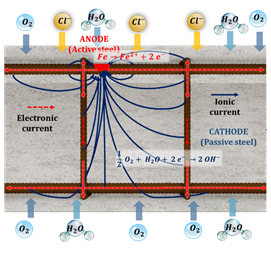A discussion on the order of magnitude of corrosion current density in reinforcements of concrete structures and its link with cross-section loss of reinforcement
DOI:
https://doi.org/10.21809/rilemtechlett.2021.116Keywords:
corrosion current density, reinforced concrete, anodic current density, cathodic current densityAbstract
This paper deals with the determination of the corrosion current density in chloride-induced corrosion in reinforced concrete structures. Because the corrosion of steel bars is generally localized, calculations of the densities of corrosion current need to take the real surface areas of anodic zones into account. Nowadays, in the lab or on site, the calculation of densities of corrosion are based on arbitrary steel surface areas, which merge anodic and cathodic zones. As a result, the order of magnitude of corrosion current density is not correct; it is underestimated. A second aspect of the paper is the relationship between corrosion current density and the prediction of service life in RC structure when including a part of the propagation phase. The consequences of the corrosion current density on mechanical properties such as corrosion-induced cracking or load-bearing capacity must consider that anodic areas grow both laterally and in-depth.

Downloads
Published
How to Cite
Issue
Section
License
Copyright (c) 2022 Raoul Francois

This work is licensed under a Creative Commons Attribution 4.0 International License.
Authors retain copyright of the articles published in RILEM Technical Letters and grant the journal the right of first publication with open access. The work is simultaneously licensed under Creative Commons Attribution 4.0 International License (CC BY 4.0) that allows others to share and adapt the work under the following terms: 1) a proper attribution is given in a form of bibliographic record with the DOI link directing to RILEM Technical Letters; 2) a link to the license is provided; 3) the changes (if any) are indicated.









